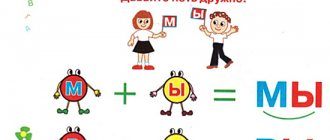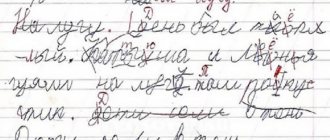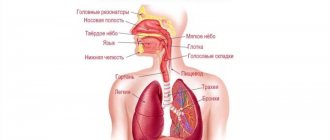Mikheeva Mila
Didactic games for developing the syllabic structure of words
Didactic games for developing the syllabic structure of words.
To make it easier for a child to learn the structure of a word , the teacher needs to involve as much motor activity as possible, since with movement the child will better consolidate speech material. Words of different syllabic structures can be clapping , tapping, jumping, stepping away, and so on.
At the preparatory stage, exercises are carried out first at the non-verbal level, and then at the verbal level.
Exercise “Repeat the same”
Goal: learn to reproduce a given rhythm.
Materials: ball, drum, tambourine, metallophone, sticks.
Progress of the exercise: The speech therapist sets the rhythm with one of the objects, the child must repeat the same.
Exercise “Count correctly”
Goal: learn to count sounds.
Material: children's musical and noise instruments , cards with numbers, cube with dots.
Didactic games for the development of sound-syllable analysis of words
8.“How many sounds did you hear?”
The teacher expressively pronounces individual sounds and syllables mixed together (m, ra, u, us, we, k...). Children clap 1 time per sound, 2 times per syllable.
9."Roll Call"
The teacher names different sounds mixed together - vowels and consonants. Children whose names begin with the named sound stand up.
10."Let's build a house"
The teacher says that he is going to draw a house and draws only one wall on the board. Children must name the parts of the house that need to be completed. You can name only those words that have the sound “r”. Children call: “Roof, attic, frame, porch, chimney. The teacher draws all the named objects schematically on the board.
11."Look up the word"
The teacher says that in the Russian language there are words that like to play hide and seek. These are short words, they are hidden in longer words. In order to find a short word, you need to divide the long one into syllables. For example, you need to find the word that is hidden in the word “sand”. (Children divide words into syllables - sand). What word was hidden? (Juice).
The teacher names other words in which the second syllable is an independent word: fisherman, Boris, pie, fist, beans, king. Children look for words “hidden” in them.
12."Carlson's Diet"
Goal: to teach how to find words starting with a given letter and read them (if it’s difficult, with the help of a teacher).
Benefits: 1) toy - Carlson;
2) cards with words:
M - milk, butter, meat, ice cream, fruit drink, marmalade, pasta;
K - candy, strawberry, coffee, cutlet, cupcake, potato, compote.
Progress: Educator: “Carlson revealed his little secret to me today. It turns out that in order to feel good and not get too fat, Carlson will go on a diet - one day he will eat foods that begin with the letter “M”, and the next day - with the letter “K”. This is what the doctor advised him and also wrote down the foods he should eat. But Carlson can’t read. So he came to us for help. Let's help him find products starting with the letter "M". Whoever finds it reads (if it’s difficult, the teacher helps). Carlson's diet can be any letter.
13."Chain of Words"
. Goal: develop attention, learn to find a word starting with a given letter.
Aids: 1) cards with words: nose, elephant, rhinoceros, geese, turkey, cow, orange, hole, watermelon, tooth, badger, mole, throne;
2) toy “Parsley”.
Organization: cards are laid out mixed on the table. Children stand around the table.
Progress: the game is played in two versions:
1. Educator: “Today Parsley will play with you. He can't read words yet, but he knows individual letters. Now Parsley will pick up a card with a word, and you must find the word starting with the last letter. Whoever finds it first gets a card. Let's see who is the most attentive and smart. For example, Parsley picks up the word “badger”; it ends with the letter “K”. You must find a word starting with this letter (mole).
Games for developing the skills of syllabic analysis and word synthesis in preschool children
Formation of the skill of syllabic analysis and word synthesis in preschool children
One of the main indicators of a child’s readiness for successful schooling is correct, well-developed speech. Good speech is the most important condition for the comprehensive development of children. Therefore, it is so important to take care of the timely formation of children’s speech, its purity and correctness, preventing and correcting various violations, which are considered to be any deviations from the norm of language.
Violation of the syllabic structure of words is somewhat difficult to correct. An insufficient level of correction of this type of pathology in preschool age leads to the development of dysgraphia in schoolchildren due to impaired language analysis and word synthesis and phonemic dyslexia (impaired writing and reading).
There is a dependence of mastering the syllabic structure of a word on the state of phonemic perception, articulatory capabilities, semantic insufficiency, and the child’s motivational sphere. According to recent studies, violation of syllabic structure also depends on the characteristics of non-speech processes.
Prevention of word syllable structure
is built on both verbal and non-verbal material. The leading at the propaedeutic stage is training:
-perception and reproduction of various non-speech rhythmic contours (slapping, tapping, jumping, etc.) -distinguishing by ear between long and short words; −auditory discrimination of syllable contours by length.
At this stage, the child is offered tasks first on non-verbal material, and then on verbal.
The next stage is to work out the syllabic structure of words using the material of sentences, phrases, texts, and poems.
Games and exercises to develop the skills of syllabic analysis and word synthesis in preschool children
- Preparatory stage.
(exercises are carried out first on a non-verbal level, and then on a verbal one)
Exercise “Repeat the same”
Target:
learn to reproduce a given rhythm.
Materials:
ball, drum, tambourine, metallophone, sticks.
Progress of the exercise:
The speech therapist sets the rhythm with one of the objects, the child must repeat the same.
Exercise “Count correctly”
Target:
learn to count sounds.
Materials:
children's musical and noise instruments, cards with numbers, cube with dots.
Progress of the exercise:
Option 1. The child claps his hands (knocks on a tambourine, etc.) as many times as there are dots on the cube. Option 2. The speech therapist plays sounds, the child counts them and picks up a card with the corresponding number.
Exercise “Choose a scheme”
Target:
learn to correlate the rhythmic pattern with its diagram on the card.
Material:
cards with patterns of rhythmic patterns.
Progress of the exercise:
Option 1. The speech therapist sets a rhythmic pattern, the child selects the appropriate pattern on the card. Option 2. The child reproduces a rhythmic pattern according to a given pattern.
Exercise “Long - short”
Target:
learn to distinguish between long and short sounding words.
Material:
chips, long and short strips of paper, pictures.
Progress of the exercise:
Option 1. The speech therapist pronounces the words, the child places a chip on a long or short strip. Option 2. The child names the words in the pictures and puts them into two groups: the long strip and the short one.
- Corrective stage.
(the work is carried out at the verbal level with the obligatory “switching on” of the auditory, visual and tactile analyzers)
Exercises at the sound level:
- “Say the sound A as many times as there are dots on the cube. Make the sound O as many times as I clap my hands.”
- “Find out what sound (series of sounds) I made.” ( Recognition by silent articulation, pronunciation with voice)
— Determination of a stressed vowel in a stressed position (in a series of sounds).
Exercises at the syllable level:
– Pronounce a chain of syllables while simultaneously stringing rings onto a pyramid (building a tower from cubes, rearranging pebbles or beads). – “Fingers say hello” - pronouncing a chain of syllables by touching the fingers of the hand with the thumb on each syllable. – Count the number of syllables pronounced by the speech therapist. – Name the stressed syllable in the chain of heard syllables. – Memorizing and repeating chains of different types of syllables.
Word level exercises:
Ball game
Target:
learn to clap the syllabic rhythm of a word.
Material:
ball.
Progress of the game
: the child beats the rhythm of the word given by the speech therapist with a ball.
Ball game “Toss and catch”
Target:
learn to divide words into syllables while simultaneously performing a mechanical action.
Material:
ball.
Progress of the game
: the child throws the ball up, while naming the syllable of the given word.
Game "Bumps"
Target:
learn to divide words into syllables while simultaneously performing a mechanical action.
Material:
rubber mats or bumps on the massage path.
Progress of the game
: the child jumps (steps over) from hummock to hummock and at the same time names the syllable of the given word.
Game "Telegraph"
Target
: develop the ability to divide words into syllables.
Material:
sticks.
Progress of the game
: the child “transmits” the given word by tapping out its rhythmic pattern.
Game "Count, don't make a mistake"
Target:
learn to divide words into syllables while simultaneously performing a mechanical action.
Material
: pyramid, cubes, pebbles.
Progress of the game
: the child pronounces the words given by the speech therapist and lays out pebbles (pyramid rings, cubes). Compare words: where there are more pebbles, the word is longer.
Ball game "Pass it on"
Target:
learn to divide words into syllables while simultaneously performing a mechanical action.
Material
: ball.
Progress of the game
: children pass the ball to each other and at the same time name the syllable of the given word.
Game "Say the correct word"
Target
: learn to distinguish correctly sounding words.
Material:
pictures.
Progress of the game
: the speech therapist pronounces the words incorrectly, the child names the words correctly (
if it is difficult for the child to complete the task, then pictures are given to help
).
Exercise “What has changed?”
Target
: learn to distinguish between different syllable structures of a word.
Material:
pictures.
Progress of the exercise
: the child explains the difference between words.
Words:
cat, cat, kitten. House, house, house.
Exercise “Find the longest word”
Target:
strengthen the ability to divide words into syllables.
Material:
pictures.
Progress of the exercise:
the child chooses from the proposed pictures the one that shows the longest word.
Exercise “Count, don’t make a mistake”
Target
: strengthen children’s ability to divide words into syllables.
Material
: pictures, cards with numbers.
Progress of the exercise
: The speech therapist shows pictures, the children show a number corresponding to the number of syllables in a word (a complication option is the number of a stressed syllable).
Exercise “Which word is different?”
Target:
learn to distinguish words with different rhythmic structures.
Material
: pictures.
Progress of the exercise
: the speech therapist names a series of words, the children identify the extra word (use pictures if the children find it difficult).
Words
: tank, crayfish, poppy, branch. Carriage, bud, loaf, plane.
Exercise “Name the same syllable”
Target
: consolidate the ability to compare the syllabic structure of words.
Material:
pictures.
Progress of the exercise
: the child must find the same syllable in the proposed words (airplane, milk, straight, ice cream).
Game “The end of the word is yours”
Target
: learn to synthesize words from syllables.
Material
: ball.
Progress of the game
: the speech therapist begins the word and throws the ball to the child, he adds the same syllable SHA: ka..., va..., Yes..., Ma..., Mi...
Game “What word did you get?”
Target:
practice simple syllabic analysis.
Material
: ball.
Progress of the game
: the child, throwing the ball to the speech therapist, pronounces the first syllable. The speech therapist, returning the ball, says the second syllable and asks the child to name the word in full.
Child: Speech therapist: Child: Boo ket bouquet Boo fet buffet Boo tone bud Boo ben tambourine
Exercise “Call me kindly”
Target
: learn to clearly pronounce words of type 6 syllabic structure when forming nouns.
Material:
ball.
Progress of the exercise
: the speech therapist, throwing the ball to the child, names the object. The child, returning the ball, calls it “affectionately.” Bow - bow, bandage - bandage, bush - bush, scarf - scarf, leaf - leaf.
Exercise “Say the word correctly”
Target
: learn to clearly pronounce words of type 7 syllable structure, develop auditory attention and memory.
Material:
subject pictures.
Progress of the exercise
: the speech therapist shows a picture and pronounces a sound combination. The child raises his hand when he hears the correct name of the object and names it.
Speech therapist: Child: Scrapper Scrapper Plane Plane
Game "Syllable cubes"
Target
: practice synthesizing two-syllable words.
Material:
cubes with pictures and letters.
Progress of the game
: children must collect words from two parts.
Game "Chain of words"
Target
: consolidate the ability to analyze and synthesize two- and three-syllable words.
Material
: cards with pictures and words divided into parts.
Progress of the game
: children lay out a chain of words (pictures) like dominoes.
Game "Logocube"
Target
: practice syllabic analysis of one-, two- and three-syllable words.
Material
: cube, set of subject pictures, cards with numbers.
Progress of the game
: children choose from a general set of pictures those that correspond to a given number of syllables and fix them on a certain side of the cube.
Train game
Target
: learn to select words with a given syllable pattern.
Material
: train with carriages, a set of subject pictures, diagrams of the syllabic structure of words.
Progress of the game
: children are invited to help “seat passengers” in the carriages in accordance with the number of syllables.
Game "Pyramid"
Target
: consolidate the ability to analyze the syllabic composition of a word.
Material
: a set of subject pictures.
Progress of the game
: the child must arrange the pictures in a given sequence: one at the top - with a one-syllable word, two in the middle - with two-syllable words, three at the bottom - with three-syllable words.
Game "Let's put things in order"
Target
: improve syllabic analysis and synthesis.
Material
: a set of cards with syllables on tinted paper.
Progress of the game
: children select syllables from the total number and arrange them in the right order.
Game "Who is more"
Target:
improve the ability to synthesize words from syllables.
Material:
a set of cards with syllables on paper of the same color.
Progress of the game:
from the total number of syllables, children lay out as many variants of words as possible.
Literature:
- Agranovich Z.E.
Speech therapy work to overcome violations of the syllabic structure of words in children. St. Petersburg: Detstvo-Press, 2000.
- Bolshakova S.E.
Overcoming violations of the syllabic structure of words in children. Moscow: Sfera, 2007.
- Volina V.V.
We learn by playing. Ekaterinburg: Argo, 1996.
- Kozyreva L.M.
We read syllable by syllable. A set of games and exercises for children 5 – 7 years old. Moscow: Gnom i D, 2006.
- Kurdvanovskaya N.V., Vanyukova L.S.
Formation of the syllabic structure of a word. Moscow: Sfera, 2007.
- Lalaeva R.I., Serebryakova N.V.
Correction of general speech underdevelopment in preschool children. St. Petersburg: Soyuz, 1999.
- Lopukhina I.S.
Speech therapy. Moscow: Aquarium, 1996.
- Tkachenko T.A.
Correction of violations of the syllabic structure of words. Moscow: Gnom i D, 2001.
- Filicheva T.B., Chirkina G.V.
Preparing children with general speech underdevelopment for school in a special kindergarten. Moscow: 1991.
- Chetverushkina N.S.
The syllabic structure of the word. Moscow: Gnom i D, 2001.







